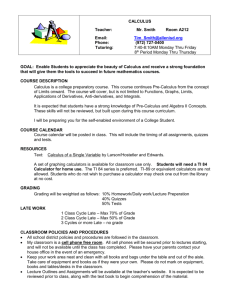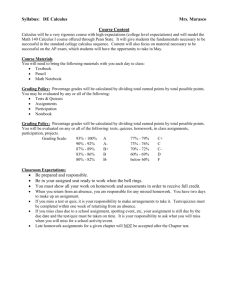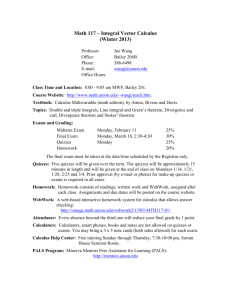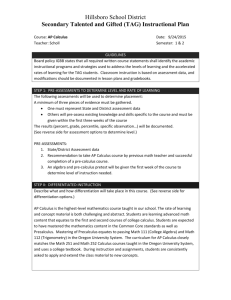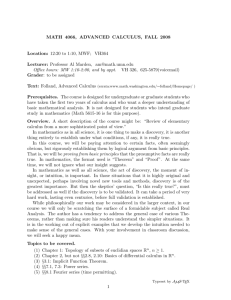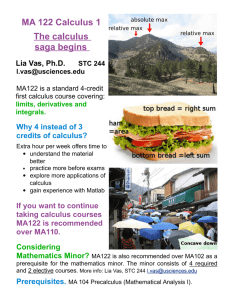(MAT222) Syllabus - Tougaloo College
advertisement
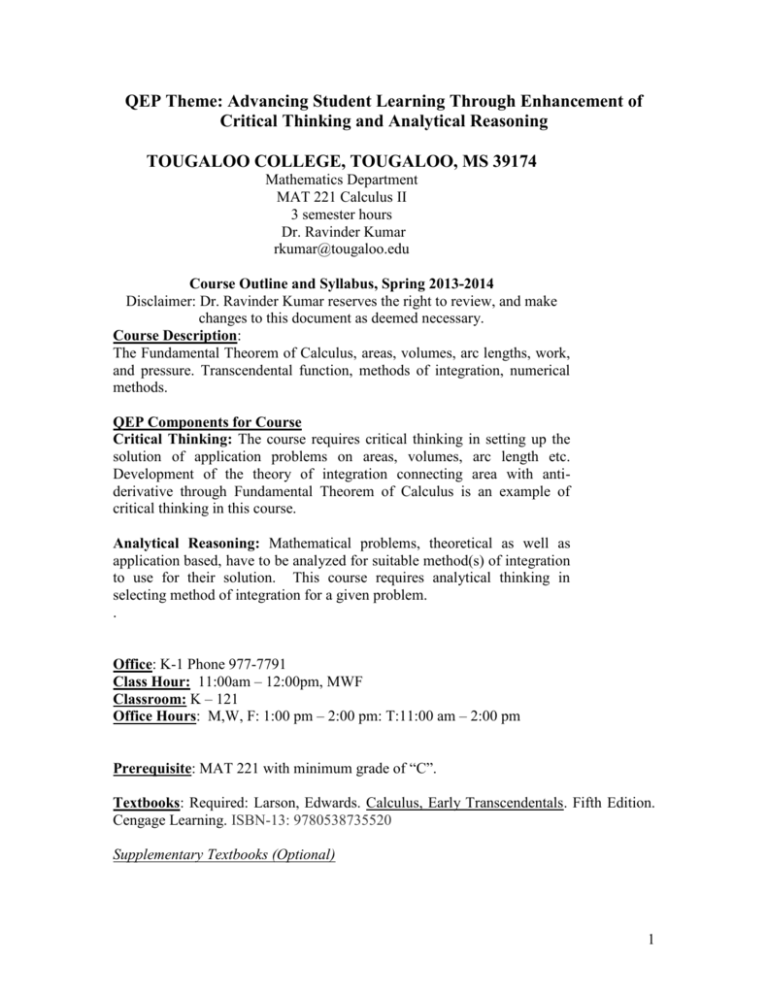
QEP Theme: Advancing Student Learning Through Enhancement of Critical Thinking and Analytical Reasoning TOUGALOO COLLEGE, TOUGALOO, MS 39174 Mathematics Department MAT 221 Calculus II 3 semester hours Dr. Ravinder Kumar rkumar@tougaloo.edu Course Outline and Syllabus, Spring 2013-2014 Disclaimer: Dr. Ravinder Kumar reserves the right to review, and make changes to this document as deemed necessary. Course Description: The Fundamental Theorem of Calculus, areas, volumes, arc lengths, work, and pressure. Transcendental function, methods of integration, numerical methods. QEP Components for Course Critical Thinking: The course requires critical thinking in setting up the solution of application problems on areas, volumes, arc length etc. Development of the theory of integration connecting area with antiderivative through Fundamental Theorem of Calculus is an example of critical thinking in this course. Analytical Reasoning: Mathematical problems, theoretical as well as application based, have to be analyzed for suitable method(s) of integration to use for their solution. This course requires analytical thinking in selecting method of integration for a given problem. . Office: K-1 Phone 977-7791 Class Hour: 11:00am – 12:00pm, MWF Classroom: K – 121 Office Hours: M,W, F: 1:00 pm – 2:00 pm: T:11:00 am – 2:00 pm Prerequisite: MAT 221 with minimum grade of “C”. Textbooks: Required: Larson, Edwards. Calculus, Early Transcendentals. Fifth Edition. Cengage Learning. ISBN-13: 9780538735520 Supplementary Textbooks (Optional) 1 1. James Stewart, Calculus, Early Transcendentals, Sixth Edition, Brooks/Cole. ISBN13: 978-0-495-38343-7 2. Swokowski, Olinick, and Pence, Calculus, Sixth Edition, PWS-KENT Publishing Company. 3. Anton, Howard, Calculus with Analytic Geometry, Second Edition, John Wiley and Sons Publishing Company. 4. Thomas and Finny, Calculus and Analytic Geometry, 8th Edition, Addison Wesley Publishing Company. Attendance: Each student is expected to be in class and to be on time. If a student is five or more minutes late then the records will indicate a tardy. If a student is tardy twice then this will be counted as an absence. If a student has more then three unexcused absences his/her semester grade will automatically drop by one letter grade. All excuses must be reported to me with the proper validation before they can be recorded in my class booklet as an excused absence. These policies are stated on current course catalog. “Tougaloo College believes that its students must learn to take major responsibility for their own education. Tougaloo students are required to attend all of their classes and be responsible for all assigned course material and all material covered in class. When students are absent from class, it is the student’s responsibility to notify the instructor and ascertain what the instructor requires regarding missed material or assignments”. If you wish to withdraw, do so officially. The "W" will not hurt your grade point average whereas the F will. Academic Integrity: It is expected that a student attending Tougaloo College will be scrupulously honest. Therefore, plagiarism, cheating or any form of dishonesty associated with this course will be dealt with in accordance with the policies of Tougaloo College. These policies are stated on the current student handbook. Class Structure: Part of each class will be used to discuss problems with previous homework assignments. New topics will be introduced and discussed. Quizzes and tests will be given. Homework will be given online using webwork. You should read the section(s) to be covered before the lecture, and should pay careful attention to what material is being developed in the lecture. Use the lecture as a guide to what material you will need to study. There is a lot of information in the book that won't be covered in the lecture but which is valuable to you as background information for better understanding the material you are expected to learn. I encourage calculators and/or computers usage in this class. A scientific calculator or graphic calculator (TI-82,TI 83 or TI-84) will be fine. Graphing calculators or computers may be used to help the student solve homework problems. The students may use the computers in Supplemental Instructions Lab (Kincheloe 105). While the department encourages the use of calculators and computer software, students are not permitted to use calculators or computer software, that have a built in Computer Algebra System, during evaluation (i.e. exams, quizzes, and final exam), for example Casio: CFX-9970G (including, for example, CFX-9970GE) and Algebra fx 2.0, Casio ClassPad; 2 Texas Instruments: TI 86, TI-89 and TI-92 (including, for example, TI-92 Plus), TINSquare CAS; Hewlett-Packard: HP-40G and HP-49G Or any other calculators with equivalent capability. Computer Software: Wolframalpha, MATHEMATICA, Scientific Notebook, MATLAB Students may not use devices that can communicate wirelessly with other devices or persons. How Critical Thinking & Problem Solving Skills Support Math and Science Design Curriculum Mathematical formulas and scientific theories are more than textbook material; they underlie the products and interactions of today’s technological society. Beyond repeating theory and formula, students need to understand how to apply math and science knowledge to different situations and challenges. Hands-on, project-based math and science curriculum activities provide opportunities for students to think critically about the use of math and science in solving problems, deepening their knowledge of the basics. For example, in completing engineering design project based on realistic constraints that professionals in the field may face, such as a change in federal safety requirements, students need to think critically about how to revise their design prototype to satisfy its design goals and meet its scientific requirements. What is calculus? What distinguishes calculus from your previous mathematics courses of algebra, geometry, and trigonometry is the transition from static or discrete applications to those that are dynamic or continuous. For example, in elementary mathematics you consider the slope of a line, but in calculus we define the (non-constant) slope of a nonlinear curve. In elementary mathematics you found average changes in quantities such as the position and velocity of a moving object, but in calculus we can find instantaneous changes in the same quantities. In elementary mathematics you found the average of a finite collection of numbers, but in calculus we find the average value of a function with infinitely many values over an interval. You might think of calculus as the culmination of all of your mathematical studies. To a certain extent that is true, but it is also the beginning of your study of mathematics as it applies to the real world around us. Calculus is a three-semester course that begins your college work in mathematics. All your prior work in mathematics is considered elementary mathematics, with calculus the dividing line between elementary mathematics and mathematics as it is used in a variety of theoretical and applied topics. Calculus is the mathematics of motion and change. Its development in the seventeenth century by Newton (1642-1727) and Leibniz (1646-1716) was the result of their attempts to answer some fundamental questions about the world and the way things work. These investigations led to two fundamental concepts-namely, the derivative and the integral. The breakthrough in the development of these concepts was the formulation of a mathematical tool called a limit. 3 1- Limit: The limit is a mathematical tool for studying the tendency of a function as its variable approaches some value. Calculus is based on the concept of limit. We introduce the limit of a function informally in Section 2.1 and then examine the concept more formally in Sections 2.2, 2.3, 2.4 & 2.5. 2- Derivative: The derivative is defined as a limit, and it is used initially to compute rates of change and slopes of tangent lines to curves. The study of derivatives is called differential calculus. Derivatives can be used in sketching graphs and in finding the extreme (largest and smallest) values of functions. The derivative will be introduced and developed in Chapter 3, and its applications are examined in Chapter 4. 3- Integral: The integral is founded by taking a special limit of a sum of terms, and the study of this process is called integral calculus. Areas, volume, arc length, work, and hydrostatic forces are a few of the many quantities that can be expressed as integrals. Integrals and their applications are studied in chapter 5,6 , 7and 8. Assignments: Homework will be frequently posted on webwork (http://webwork.tougaloo.edu/webwork2/MAT222/). Please visit this website every day and look for email announcements for the online homework. These assignments should be completed in preparation for quizzes, tests and final examinations. If you don't do your homework you will not do well in class. Webwork generates individualized homework problems. You will be asked to generate your copy and print it or save it. You are advised to actually do these problems with paper and pencil. You may be asked to submit your work for webwork assignments from time to time for earning the full credit reported by webwork. You will be asked to do problems that you may not be very good at. You should always try to do the best job you can, because that is how you improve your skills. Never give up. Never try to do the minimum. Just "getting by" is surely a bad idea. If you have problems with the course, you should make an appointment with me and make plans to solve these problems early in the semester. All written assignments should be completed on time, typewritten or computer based. All paper is to be typed according to APA style. Reading It is very important to pre-read and post-read topics from your book. This will help improve comprehension of the course work as the grades. It is expected that students will do the pre-reading before the start of a topic in the class as well as do reading of topics/pages assigned in the class. Refer to the course calendar at the end of this document I am here to help you learn the material. If you are having problems, see me right away. Do not wait until the day before a test. Talk with me to set up a time when we can get together. 4 Assessment 1- Two tests, worth 100 points each, will be given. 2- One take-home test for 100 points will be given at the end of the semester as a test grade was well as preparation for the final exam. 3- Home work will count for one test grade. 4- Quizzes and a writing assignment together will be counted for one test grade 5- You can earn extra points. Always be prepared for in-class pop-up questions for bonus points. 6- Late assignments are not fair to the class professor or other students and will therefore carry a HARSH penalty. Any assignment handed in late will incur a penalty of 10% deduction of marks for every day or part of a day that it remains not submitted. Not accepted after one week. 7- Final examination will be comprehensive. It will be counted for 200 points or equivalent to two test grades.. 8- Letter grades will be assigned as follows: A B More than 88% More than 78% C More than 65% D More than 50% F Less than 50% 9- An important part of studying is getting ready for a test. This includes testing yourself to see if you can answer the kinds of questions you are likely to be asked. 10- All Exams will be closed book and notes, and will include all material covered, including any homework and quizzes. 11- Mid-term grades will be determined by Exams, Homework, in-class activities, Quizzes given prior to the day of midterm. Grading scale will be same % as in #8 above. Missed Work 12- All quizzes and assignments are online. No make-up for assignments and quizzes will be given. 13- If you happen to miss a test, it is your responsibility to contact me on the first day of attendance after missing the test to reschedule the make-up. Make-up work will be harder than the original. Parental/Guardian Tracking of your Progress Please fill the form that will be passed onto you in the class. Filling of this form is mandatory whether you want to allow your parents/brother/sister/guardian etc. to discuss your progress with me, in case you indicated so on FERPA; or otherwise. Note to seniors and other students. If you are taking this course to satisfy the graduation requirements, I cannot treat you any different from any other student. Your final grade is strictly based on your 5 performance in homework, quizzes, tests, and other class activities. There is no extra credit by any means. Please drop the class or withdraw. Make your decision right now before it is too late. I am sorry I am not of any more help to you. You will be given final exam based on complete syllabus. Special Needs Statement (Proposed): If you have a disability for which you are or may be requesting an accommodation, you are encouraged to contact both your instructor and the Student Disabilities Service team. Expected Tougaloo College Student Outcomes: The expected outcomes are stated on the current course catalog. Course Content and Calendar The course work will adhere to the following course calendar. This will help in your prereading as well as preparing the topics assigned for reading on your own from time to time in the class. References are from your book. Webwork assignments will be given on a regular basis. Date 01/22/2014 01/24/2014 01/27/2014 01/29/2014 01/31/2014 02/03/2014 02/05/2014 02/07/2014 02/10/2014 02/12/2014 02/14/2014 02/17/2014 02/19/2014 02/21/2014 02/24/2014 02/26/2014 02/28/2014 03/03/2014 03/05/2014 03/07/2014 Topic Intro to Class, Into to Int Calc Antiderivative WebWork and Moodle Tutoring Area Sigma Notation, Riemann Sums Riemann Sums: Hands-on Definite Integral The Fundamental Theorem of Calculus Fundamental Th: Hands-On Integration by Substitution: HandsOn Integration by Substitution: Hands-on Numerical Integration: Hands-on Numerical Integration: Hands-on Integration using log Functions Review of Inv Trig and Hyperbolic Functions Integration using Inv Trig Functions: Hands-on Integration using Hyp Functions: Hands-on Volume: Disk Method Volume: Shell Method Test Chapter 5 Section 5.1 5.1 Reading/Test/Quiz Reading: 5.2 5.2 5.3 5.3 5.3 5.4 Reading: 5.3 5.4 5.5 Quiz on Riemann Sums 5.5 5.6 5.6 5.7 5.8 & 5.9 Reading: 5.4 Quiz: Int by Substitution 5.8 5.9 Quiz Numerical Int 6.1 6.2 Test 6 03/09/2014 03/17/2014 03/19/2014 03/21/2014 03/24/2014 03/26/2014 03/28/2014 03/31/2014 Hands-on Arc Length Surface Area Hands-on Work, Hands-on Center of Mass Center of Mass Hands-on 6.1-6.2 7.4 7.4 7.4 7.5 7.6 7.6 7.6 04/02/2014 04/04/2014 04/07/2014 04/09/2014 Basic Integration Rules Integration by Parts Test: Chapter 7 Integration by Parts 8.1 8.2 04/11/2014 04/14/2014 04/16/2014 Trig Integrals Trig Substitution Hands-on 8.3 8.4 8.4 04/23/2014 04/25/2014 Partial Fractions Method of Partial Fractions: Handson Indeterminate Forms Improper Integrals Improper Integrals Reading Day Comprehensive: Content: 40% before MidTerm, 60% after MidTerm 8.5 8.5 04/28/2014 04/30/2014 05/02/2014 05/05/2014 Final Exam Reading: 7.5, 7.6 Quiz: Volume Reading:8.1 Test Quiz: Integration by Parts 8.7 8.8 8.8 Reading Partial Fractions Take-Home Quiz: Substitution Take-Home due 7 STUDY HINTS Mathematics is different from other subjects in that the quantity of reading material is usually not great. It is much more important to remember that each word of a reading assignment must be understood. It is not unusual for a student to read a section in the textbook several times. Reading speed is of little benefit in mathematics. In general, it is better to go quite slowly, letting the meanings seep in. Also, pausing frequently to go over in your mind what you have just read, saying these ideas in your own words, and trying to relate them to what you have already learned are excellent steps to learning. Time spent on thoroughly understanding the reading material will mean that less time will usually be required to do the problems. The great temptation is to go immediately to the written assignment and look back in the text to find an example to fit the requirements of the problem at hand. This method may work on some problems, but the overall goal of understanding the course material is defeated. Problems worked in this way rarely stay in the memory long. First, carefully read all the examples given, and actually work them with paper and pencil along with authors, then use the written assignment as a mini test, looking back for hints in the text only when you need to. In this way you will find that the idea in the section will become your own. This means that when test time rolls around, review of your lessons will bring back to your mind all that you have learned, and you will be equipped to perform well on the test without the crutch of the text examples. I am here to assist you in learning the content of this course. I welcome the opportunity to serve you. Please don't hesitate to contact members in mathematics department, and/or myself as soon as you feel that you need additional help. Computer Use at Tougaloo College: The Microcomputer Labs, located on H-21 and K-105, offer IBM compatible for use by Tougaloo students. A variety of software applications, including word processing, spreadsheet, database management are provided. Also available: MATHEMATICA, Maple, ALGEBRA...etc. Each is a unique new way to work with formulas, numbers, and graphs. Staff assistance, software documentation, and additional guidelines and procedures are available in the Microcomputer Center. You must supply diskettes to maintain your documents or data. Individual 3.5" diskettes are available for sale in the bookstore. Remember: NOT WHAT YOU LEARN BUT WHAT YOU CAN RECALL MAKES YOU A WISE STUDENT. 8 Helpful Websites: These websites are helpful in the learning of calculus. Some of them may be helpful for pre-requisite materials or other math courses too. http://www.analyzemath.com/calculus_questions.html http://khanacademy.org http://patrickjmt.com http://www.openculture.com/math_free_courses http://www.calculus.org/ http://www.calculus-help.com/tutorials/ http://midnighttutor.com/ http://www.karlscalculus.org/links.html http://www.exampleproblems.com/wiki/index.php/Calculus http://www.math.temple.edu/~cow/ http://www.quickmath.com/ http://tutorial.math.lamar.edu/ APA Style Referencing http://www.library.cornell.edu/resrch/citmanage/apa (Examples of references) http://citationmachine.net/ (helps create references) 9

